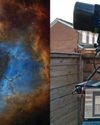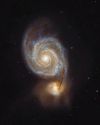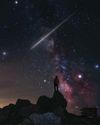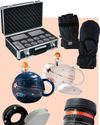
Ever since I first became interested in astronomy, I have been fascinated by the iconic images of Earth rising above the lunar horizon from the Apollo missions. When I realised that the Moon's occultation of Venus, visible on 19 June 2020, would give me the opportunity to capture a similar image for myself, it immediately became one of my astrophotography aims of that year. I decided to capture the event with a very narrow field of view in order to enhance the 'crescent over lunar horizon' feeling and I also wanted to capture the event in colour to record the daylight blue sky. To achieve this, I used my Celestron C11 equipped with a colour planetary camera at prime focus.
In order to achieve a natural look to the image, I chose short exposures so as not to oversaturate bright Venus. This made the crescent Moon's limb barely visible in the shots (see image, right). To compensate for this low contrast I had my planetary camera's gain set to zero, so the noise in individual frames would be as low as possible. Unfortunately, some low cloud moved in during the capture a few seconds after the Moon began to hide Venus, and obscured the scene. When the sky was blue again, Venus had totally disappeared, so I took more shots of the Moon, this time with longer exposures to better reveal the details of the lunar limb.
Stacking Venus
This story is from the {{IssueName}} edition of {{MagazineName}}.
Start your 7-day Magzter GOLD free trial to access thousands of curated premium stories, and 9,000+ magazines and newspapers.
Already a subscriber ? Sign In
This story is from the {{IssueName}} edition of {{MagazineName}}.
Start your 7-day Magzter GOLD free trial to access thousands of curated premium stories, and 9,000+ magazines and newspapers.
Already a subscriber? Sign In

Putting cosmic rays to work
These penetrating interstellar particles have applications from astronomy to archaeology

Set up your first imaging sequence
How to automate and coordinate your gear over multiple nights of imaging

The Universe without gravity
Life with no gravity might sound a fun idea, but as Govert Schilling explains, shutting off this pivotalforce would spell disaster for Earth and beyond

How to blend images taken with different camera setups
Combine data captured at varied focal lengths to create rich, deep images

INSIDE THE SKY AT NIGHT
Back in September 2021, The Sky at Night show spoke to Carly Howett about NASA's then upcoming Lucy mission. As the spacecraft now approaches its main targets - the Trojan asteroids - we check in with her to see how the mission is going

The science of SCI-FI
We love a good sci-fi film, but do they get the science right? Amy Arthur picks six of the big mistakes made in space films

Seeing in a new light
It's National Astronomy Week this month, so take a tip from Mark Westmoquette and let mindful stargazing change your perspective on your life and problems

What to do if you find a meteorite
Ever come across an unusual rock and wondered if it's a meteorite? Mark McIntyre explains how to tell if that stone really is a fragment from outer space

GEAR
Charlotte Daniels rounds up the latest astronomical accessories

Q&A WITH A STELLAR ECLIPSE SPECIALIST
Many stars are gravitationally locked inside multi-star systems, but a rare new triple-star system has set a new record for how cosy these clusters can get